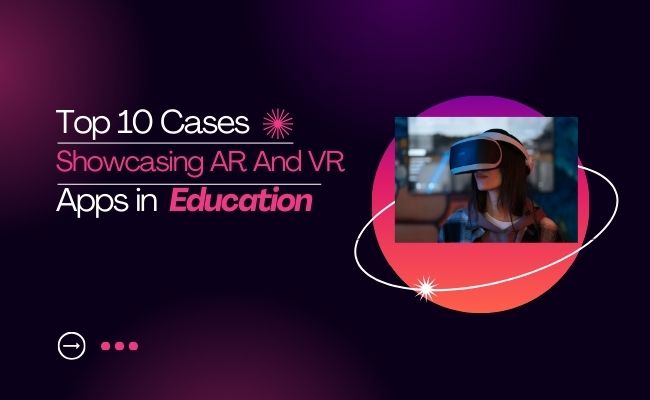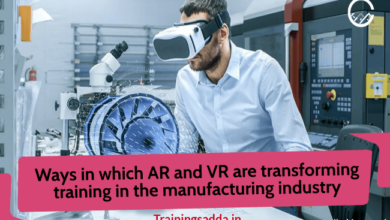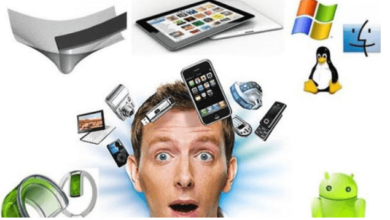Top 10 Cases Showcasing AR And VR Apps in Education

Last Updated on November 3, 2023 by admin
The academic world has been slowly but significantly impacted by augmented and virtual reality. There are now tests that could be conducted that would be impossible in the actual world.
In response to the pandemic, several schools have begun using augmented reality (AR) and virtual reality (VR) as supplementary learning aids for a variety of courses. This blog demonstrates how augmented reality in education may be used in the classroom and explores its possible benefits.
Table of Contents
Challenges of AR/VR in the education industry
Teachers and students alike may benefit from augmented and virtual reality applications in the classroom. The ability to better visualize and connect with the material may help students overcome problems such as low study motivation and poor recall of previously taught material.
Adapting lesson plans on the fly may be difficult for teachers utilizing augmented reality equipment. Virtual reality (VR) has not yet made a significant impact on the classroom because of its prohibitive price tag, limited availability, and lack of high-quality material. Using the mobile channel, namely low-cost AR/VR mobile app development, is one approach to resolving these problems.
AR/VR Use Cases
As resources for creating VR/AR material have grown, so too has their use in classrooms throughout the globe. Smartphone-based innovations may have a profound effect on the classroom by 2023 and beyond. It’s possible that practicing problems may replace memorizing as the main study strategy for exams.
Learn more: Educational Apps – How To Use Them To Further Your Career
Universities and colleges should form relationships with industry forerunners in sectors like augmented and virtual reality to guarantee that teachers have access to and are able to properly deploy cutting-edge technology in the smart classroom. Here are a few examples of when augmented and virtual reality applications might be useful.
1. Virtual Trips to History and Geography
As a means of enhancing their students’ knowledge of history and geography, teachers may utilize augmented and virtual reality (AR/VR) to take them on virtual field excursions to various times and locales.
With the help of cutting-edge technologies like AR and VR, today’s kids may get a taste of what it was like to live in other periods and countries. The learner is not passively receiving information as in the case of passive media like a movie or book.
This paves the way for field expeditions to areas that were previously inaccessible. They can stay in their pyjamas and yet see world-class museums and stunning aquatic landscapes.
AR technology allows for digital information to be overlaid on physical items or historical documents. Scanning a page of a textbook with augmented reality software might display 3D models, films, and other content.
Virtual field tours might be useful for students since they allow them to see the world from the perspectives of individuals from various cultures and historical eras.
2. Medical training and learning
The use of augmented and virtual reality models in medical education and training has increased, particularly those depicting surgical procedures and anatomical characteristics.
Virtual reality simulations might provide a safe alternative to real-world patient care for medical students and professionals. It’s helpful to make mistakes and gain knowledge from them.
The immersive nature of virtual reality (VR) coupled with the availability of detailed, 3D human body models viewable from any angle has the potential to greatly improve educational outcomes.
Using VR to simulate uncommon or complicated scenarios that students are less likely to experience in real-world clinical settings has the potential to improve medical education.
Know more: 10 of The Best Virtual Classroom Softwares
3. Classroom training
The use of augmented and virtual reality in traditional classrooms has promise. You may utilize them to provide your students with a more interesting and exciting education.
By superimposing interactive components over real-world objects or conventional textbooks, augmented reality (AR) has the potential to deliver interesting and thought-provoking learning experiences. Using augmented reality in learning might help students visualize abstract ideas.
Because of its adaptability, augmented and virtual reality holds great promise as a teaching tool in a range of educational settings. Teachers may better cater to each student’s needs by allowing them to explore lessons at their own pace and in ways that pique their interest.
The use of augmented and virtual reality allows for the visualization of chemical structures and mathematical calculations in three dimensions. Using VR, students may be able to learn about past civilizations and events in more detail.
4. Student recruitment
Promotional and directing uses of AR/VR technology in the field of education are becoming more common. Prospective students may now take fully interactive virtual tours of campuses, buildings, and courses.
Taking a virtual tour of a school may give prospective students a better feel for the facilities, resources, and culture of that institution. Students who live far away from campus or who are studying abroad might benefit greatly from this.
Schools may utilize AR/VR to show prospective students what it’s like to study there, meet the professors who teach the subjects they’re interested in, and learn about the many career opportunities available to them after graduation. Students are more likely to choose a degree with real-world application as a result.
Online orientations may be a great way for freshmen to become acquainted with the institution and all it has to offer. It’s feasible that today’s market may reward educational institutions that provide AR/VR programs. It’s obvious that you value creative, experiential learning.
5. Remote learning
Students all around the globe now have access to the same classroom materials because of the widespread adoption of AR and VR technologies.
The advent of augmented and virtual reality technology has the potential to open up new worlds to pupils. Students in low-income communities or those in remote locations would benefit greatly from this.
Augmented and virtual reality (AR/VR) have the potential to provide a more technologically advanced version of the hands-on learning environment seen in traditional classrooms. Even when separated by enormous distances, this helps keep individuals feeling connected and included.
The realism of a virtual world makes it an appealing testing ground for academic skills. A virtual lab is one possible setting for scientific investigation.
The use of AR/VR technology might be of even greater benefit to kids who have impairments or other special needs. They may be able to attract a more varied group of students by offering a wide range of course options. Media like movies, 3D models, and interactive exercises may be added to traditional textbooks using augmented reality.
6. Doing homework and assignments
By providing useful context, information, and interactive components to the learning process, augmented and virtual reality technologies may make it simpler to complete tasks and assignments.
Media like movies, 3D models, and interactive exercises may be added to traditional textbooks using augmented reality.
Augmented and virtual reality (AR/VR) environments may provide a more engaging and long-lasting educational setting by appealing to several senses. Two examples are the utilization of virtual laboratories and the study of 3D models of artifacts from the past.
Students may benefit from doing in-depth research utilizing AR/VR technology to explore subjects. Students may have a more engaging and fruitful online learning and assignment experience if they make use of augmented and virtual reality technology.
7. Explaining difficult concepts
Real-world examples are one way that AR and VR have the potential to aid students’ learning across a wide range of disciplines.
Augmented reality (AR) and virtual reality (VR) allow for the creation of visual, interactive representations of abstract notions like mathematical formulae and scientific concepts.
When students interact with course material via the use of simulated artifacts or settings, this is known as active learning.
Virtual reality (VR) might provide a more immersive, three-dimensional learning environment for students in fields like geometry and engineering, where a grasp of spatial linkages is vital. Teachers may be able to provide their pupils access to the most advanced learning resources by creating AR/VR material for classroom usage.
8. Group learning
Students from all over the globe may have meaningful conversations, explore new learning spaces, and work together on projects thanks to augmented and virtual reality.
Students’ abilities to collaborate on projects and communicate with one another might benefit from the use of virtual reality (VR) technologies that allow the creation of shared virtual environments.
Students in various places may collaborate on the same project or educational experience as if they were in the same room thanks to augmented and virtual reality.
The use of technology to encourage student participation and the exchange of ideas has the potential to create a more welcoming and inclusive learning environment.
It’s possible that augmented and virtual reality technologies might aid teachers in breaking down difficult ideas and boosting student interest.
9. Distinctive Cultural Variations
Putting students in situations where they encounter people, places, and items from other origins and cultures may increase their knowledge and appreciation of diversity via the use of augmented and virtual reality technology.
Teachers may give their pupils a taste of life in any part of the globe by using virtual reality Young individuals who engage with various cultures via augmented and virtual reality experiences may grow up to be more empathetic.
Studying abroad and other cross-cultural experiences might be intimidating, but students who utilize virtual reality to see numerous cultures may feel more prepared.
The possibility exists for cross-cultural understanding and acceptance to be fostered via cultural immersion programs.
10. Learning a New Language
Because of the greater interactivity and realism they provide, AR and VR have changed language training. By immersing them in realistic settings with native speakers, virtual reality (VR) has the potential to make learning a new language much more tolerable and enjoyable.
Teachers may help their students get a better understanding of cultural-linguistic distinctions by using augmented and virtual reality (AR/VR) in language instruction.
Augmented and virtual reality (AR/VR) has the potential to significantly improve language learning by combining visual, auditory, and kinesthetic features.
Also Read: 20 Education Apps for Android and iOS
Conclusion
Education is evolving as a direct result of developments in augmented and virtual reality technologies. Especially in a lockdown scenario brought on by a pandemic, AR/VR will be more broadly available thanks to new head-mount displays and smartphone apps that offer scaled immersive experiences at an optimal cost. Virtual reality and similar immersive technologies have the potential to revolutionize the educational landscape.
Comments
0 comments




